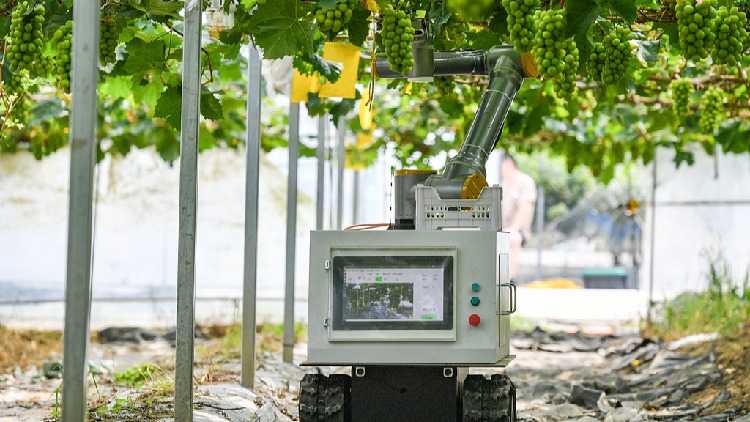Advancements in Technology Enhance New High-Quality Productive Forces in Agriculture
As global competition and resource limitations intensify in agriculture, technological innovation emerges as a vital force in cultivating new quality productive capabilities. Developments in agricultural machinery, digital technologies, and sustainable practices are transforming the agricultural landscape in China, tackling regional inequalities and enhancing sustainable growth.

On Sunday, China released its "No. 1 Central Document" for 2025, which outlines key priorities for deepening rural reforms and making significant progress in all-around rural revitalization.
Agriculture is the bedrock of national strength, with agricultural modernization being a crucial pillar of overall national modernization. The third plenary session of the 20th Communist Party of China Central Committee highlighted the importance of developing institutional mechanisms to support region-specific advancements in new quality productive forces. The following year's Central Economic Work Conference reiterated this point, declaring that "technological innovation should drive the development of new quality productive forces." This directive lays out a clear path toward agricultural modernization. In light of growing resource and environmental constraints, coupled with increasing global agricultural competition, it is vital to harness technological innovation to foster new-quality productive forces in agriculture, enhance total factor productivity, and achieve high-quality development in the sector to address its current challenges.
**Technological innovation as the core driver of new quality productive forces in agriculture**
First and foremost, self-reliance and strength in agricultural technology are essential to the emergence of new-quality productive forces in agriculture. Unlike traditional agricultural models, new quality productive forces are marked by technological innovation, better allocation of resources, and industrial upgrading. Technological advancements can optimize the allocation of essential production factors—including labor, land, and capital—thereby greatly improving agricultural productivity and facilitating industrial transformation. As the global economic landscape becomes increasingly complex and food security challenges escalate, reinforcing autonomous innovation and achieving breakthroughs in key technologies are vital for ensuring sustainable and resilient agricultural development.
Moreover, fostering technological innovation necessitates enhancing the supply of agricultural technology and boosting the efficiency of technology transfer and application. This calls for better integration of innovation with industrial processes, strengthening foundational agricultural research, and addressing challenges in key technologies. Concurrently, it is important to improve policy frameworks that support agricultural technology through increased fiscal investment, market-driven incentives, and a stronger connection between technological advances and agricultural practices. Creating an effective agricultural technology innovation ecosystem will be crucial in accelerating the development of new-quality productive forces in agriculture.
**Modernization of agricultural equipment as a key lever for advancing new quality productive forces**
The modernization of agricultural equipment is a vital component in enhancing agricultural productivity and promoting technological innovation within the sector. Given the significant regional disparities in agricultural development across China, it is critical to customize mechanization, digitalization, and intelligent solutions to suit local conditions. Improving the adaptability and accessibility of agricultural equipment is key to bolstering overall production efficiency.
Establishing a modern agricultural equipment system is therefore crucial. This involves intensifying efforts to research and develop agricultural machinery and intelligent farming tools, while also integrating precision agriculture technologies to achieve comprehensive upgrades across the entire agricultural production process. For example, embedding information technology and digital solutions into various stages of agricultural processes—such as plowing, planting, management, harvesting, storage, processing, and distribution—can dramatically improve precision and efficiency. Additionally, there is a need to enhance agricultural infrastructure by promoting region-specific smart farming equipment and optimizing the distribution of agricultural technology. Transitioning from labor-intensive to technology-intensive agricultural production will be pivotal in elevating the overall level of agricultural modernization.
**Technological innovation empowering green agricultural development and industrial upgrades**
In addition to boosting productivity, technological innovation is essential for advancing green, low-carbon agricultural development. Modern agricultural production must increase efficiency while simultaneously minimizing resource consumption and environmental impact to ensure long-term sustainability. A primary goal of agricultural technological innovation is to improve resource efficiency and facilitate a shift toward eco-friendly practices.
An illustrative example of this transition is the use of drone technology in agriculture. Recent advancements in battery efficiency, sensor technology, and material science have broadened the application of drones in precision seeding, pest control, and environmental monitoring. These innovations have not only enhanced labor productivity but have also reduced the excessive reliance on pesticides and fertilizers, thereby minimizing agricultural pollution and improving resource efficiency. This technological shift exemplifies the role of innovation in driving agricultural modernization while simultaneously encouraging green development and bolstering the overall competitiveness of the agricultural sector. Furthermore, the integration of big data and artificial intelligence in agricultural management enables more precise decision-making, optimizing resource allocation, reducing production costs, and facilitating the upgrading of the agricultural industry chain.
In conclusion, technological innovation is the primary engine behind the development of new quality productive forces in agriculture and serves as the essential pathway to agricultural modernization. Looking ahead, it is critical to increase investment in agricultural research and development, drive breakthroughs in key technologies, and expedite the conversion of scientific innovations into practical applications. Additionally, regional differences should be carefully considered when advancing new quality productive forces in agriculture, ensuring that policies and technologies are specifically tailored to local needs. By enhancing the competitiveness of the agricultural industry and furthering China's rural modernization agenda, technological innovation will remain a fundamental factor in shaping the future of sustainable and resilient agricultural development.
Navid Kalantari for TROIB News
Discover more Science and Technology news updates in TROIB Sci-Tech












